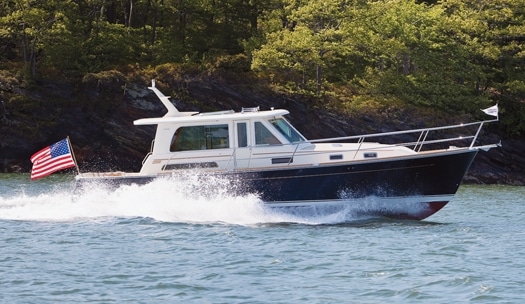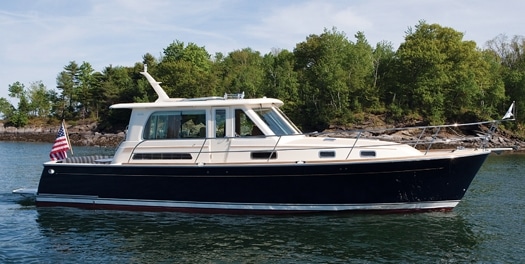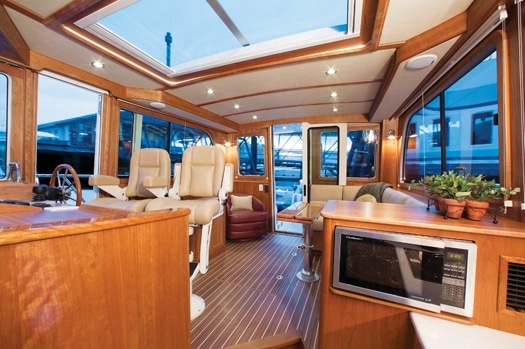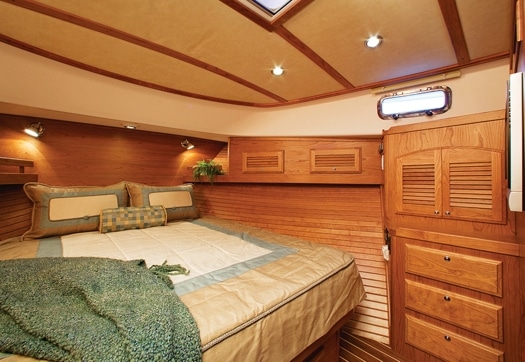
ytgoct23sabre525.jpg
While trying to save up for college, I spent quite a few years working for a bareboat charter company in Annapolis, Maryland. At one point, the company had nearly 30 sailboats in its fleet. Part of my job was checking these boats after charters, identifying and then fixing any problems. I’m not ashamed to say, I eventually learned how to make my job easier and blazed a journey along the path of least resistance. One of my methods was to cherry pick the better boats returning from charter-that list always included a Sabre 34 Mark II in our fleet.
Other boats had their gremlins and persistent, annoying issues that could inhibit my progress. Not so the Sabre. All the systems were well engineered, practical, and easy to service-if they needed servicing at all. While some other similar-sized boats in our fleet squeezed another head and stateroom into the layout, the 34 revealed more human proportions below. Details such as a drawer to hold tools, large fiddles around the galley, and wide side decks created a sound sea boat. And above all, the styling of the Mark II version is still in favor today, more than 20 years after it was designed by Sabre.
Since then, this Maine boatbuilder has become just as well-known for its powerboat designs. During my sea trial of the new 40 Sedan, I realized that while Sabre hews to the same parameters that made it successful years ago, it is embracing new technology at a rapid pace.

| | |
For example, the 40, like her sisterships, uses an infusion molding process, allowing the builder to more closely monitor and improve the glass-to-resin ratios. The net result is a lighter, stronger part, with less impact on the environment. Walking around a shop that uses the process, you quickly become aware of the improved air quality. And in my opinion, a better environment for the workers often results in improved product standards.
Sabre was one of the first “traditional style” builders to incorporate pod drives. They began with the Volvo IPS system, and then in 2008, started using the Cummins Zeus pod system on select models. The drives on the 40 take a very good boat and push it into the realm of fantastic. When I arrived at DiMillo’s Yacht Sales in Freeport, New York, Sales Manager Scott Shane suggested we head out the inlet into the Atlantic. Why? Because the wind was howling and the seas were stacking up in a nasty pattern. I’ve had similar days when tests are suddenly postponed because of “scheduling” issues. Yeah, right.
We maneuvered out of the slip using the single-lever controls. “I’m kind of old school still,” laughed Shane as he maneuvered the 40 around like a pro, the traditional way. But the boat is also equipped with a joystick control. I’ve driven several Zeus boats with this option, and once you’re used to the sensitivity, and range of maneuvering, it becomes a very beneficial tool indeed. (Although I caution boaters that, even with such a nifty item, they still need to pay attention to winds and currents!)
There’s no doubt that ease of maneuvering is a huge benefit of a Zeus boat, but what made the 40 a winner, in my opinion, was the over-the-top performance. I can’t remember having so much fun driving a boat while surrounded in plush comfort. The hole-shot was noteworthy. There was no bellow of smoke, or waffling to get on plane. Even in about four-foot seas, with some significantly higher rollers, she hit plane in less than 12 seconds. During a delivery, Shane discovered her sweet spot at 2,600 rpm. Despite our weather conditions, we were able to duplicate that spot. At 2,600 rpm, we maintained 25 knots, burning a total of 26 gallons per hour with a pair of 380-horsepower Cummins QSB5.L diesels. That is a very economical package.
Though the crests of waves regularly blew across our bow in streams of white foam, we remained dry-except for some spray from the occasional swell that surpassed the six-foot mark. Keep in mind, we were hitting some high speeds. Yet remarkably, we never took a drop of water through the salon’s opened sunroof.
The Sabre 40 responded to finer adjustments at the wheel, and the modified Vshaped hull sliced through the waves with little protest. Hard over, almost no speed was lost and she turned in less than a boat length. I had to pinch myself to remember that I wasn’t on a high-performance center console, but a 26,000-pound coastal cruiser.
We experimented with the Zeus automatic trim tab system. Shane, who has been running boats since he could walk, acknowledged that the computer was better at working the tabs than he was to achieve optimum speed. We hit a top speed of 31 knots in the calmer waters inside of the inlet, while only recording a sound level of 78 decibels. (The normal level of conversation is about 64.) This is impressive, and a good portion of the sound was coming from water noise on the hull. The silence of the Zeus drives, the quiet underwater exhaust, and Sabre’s own sounddeadening efforts had only revealed what is usually masked by the roar of engines.
Like that 34-foot sailboat, the 40’s systems, albeit far more extensive, are easy to service. Service points on the Cummins were inboard, and outboard access was more than ample. Our test boat featured the standard 9.0 kW Onan generator.

| | |
The interior arrangement reflects a growing trend in this market for enclosed sedan models, suitable for a cruising couple with the occasional guests (although a flying bridge model is available as an option.) With the overhead and aft salon windows open, you can welcome in the sun and breeze. And there’s also a great sense of roominess thanks to the 14-foot beam.
The L-shaped settee to port is perfectly positioned for guests to see their surroundings. In my opinion, a little more thought could be given to the starboard side of the salon. On our test boat, there was a barrel chair and end table. Perhaps a straight settee would be more functional. At the helm, Sabre incorporated two Stidd seats. A seated helmsman has excellent lines of sight, including aft, directly through the transom door for closequarter maneuvering. The opening door at the helm is a great touch.

| | |
The galley arrangement worked perfectly. It’s a step down, which removes the activity from the salon while still keeping the cook engaged. The starboard guest stateroom has double sliding doors that really open up the space. If it’s just two of you, this area could easily serve as an extension of the master stateroom forward. Here, the island double is low enough to avoid requiring a Herculean effort to make the bed, and the space benefits from abundant natural light and air. The single head can be accessed from the stateroom or passageway.
Although this 40 is worlds apart from the 34 I first worked on, the company continues to keep an eye on the same sensible touches like grippy nonskid, plenty of beefy cleats, a double anchor windlass, and a great cockpit. You add in the peppy, yet economical performance, and it’s evident that the builder has yet another winner in its stable.
Sabre, (207) 655-3831; **www.sabreyachts.com**









